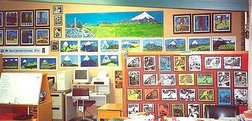
 It is early days yet in our classrooms but not too early to get a picture of what has been achieved so far by individual teachers.
It is early days yet in our classrooms but not too early to get a picture of what has been achieved so far by individual teachers.Perceptive teachers will by now have developed environments that clearly indicate the important messages they want their students to gain while in their classroom. Equally perceptive principals – that is if they are educational leaders – will have indicated agreed school expectations to all teachers.
Take a quick walk around the classrooms at your school to see what impressions they give to you – a good idea is to pretend you are taking around a group of new parents or visitors.
This is not as superficial as you would think. Malcolm Gladwell in his book ‘Blink’ talks about ‘thin slicing’ – the ability to gather a lot of information in a glance. Of course the quality of the information depends on the expertise of the individual. Wine connoisseurs can tell at a sip the quality of a wine while others of us are none the wiser after a bottle!
So what does your room environments tell about what the school values?
Before you say it is to early – think if you were opening a new shop in the local mall – would you leave first impressions to chance?
Are the room’s colourful, exhibiting student’s art and examples of work from their projects? By now the first class unit of the year ought to be coming to fruition. Does the room reflect the key questions for the unit and outline expected tasks?
Do the class whiteboards / blackboards illustrate teacher planning and management?
And do the student books that are in view show an effort to inculcate appropriate design and presentation standards – by Easter the student’s book work should be showing qualitative improvement in design and content but only if that is the teacher and school expectation.
Is their evidence of negotiated class rules and behavior expectations to be seen?
All this can be taken in by an expert 'blink' – the power of 'thin slicing'. Equally for those without the expertise the room could be patchy, flat, and dull, and not even be noticed.
If I were a parent I would avoid such rooms – but luckily most parents are not so aware - or are they?
For a teacher who understands the power of design and emotions it is a great point of differentiation. It I were a teacher today I know what you would see if you came into my room – I wouldn’t leave it to chance! And I would have to tell you – you would see it at a glance.
Ideas to halp:
Classroom criteria
Presentation of student work
Developing a sense of quality
Classroom display for unit of work
4 comments:
Somehow I don't think people see classroom environments as important as you do?
I am sure you are right - I guess it must come from my art adviser background.
And as well it is early days yet - but environments do send out 'messages' but some might not be equiped to see them.
Most secondary teachers don't see it as important - except for the art teachers!
What you see in classrooms depends on the teacher or the schools priorities.
I like rooms with that 'wow' factor!
Room environments tend to reflect the level of respect teachers have for their students. Teachers who promote interesting and aesthetic room environments also seem to have a strong personal learning philosophy and commitment to promoting quality and depth of thought in all children's work. You are right, you can learn a lot about what is going on in a classroom, or not, by looking at classroom displays.
Could not have said it better myself.
Imagine a school full of such teachers who share such a philosphy - there would be no need for all those endless turgid folders principals think they can run schools by!
And no ERO or Ministry technocrat would dare criticize!
One day such a school will emerge! Already there are school pretty close to achieving this!
Post a Comment